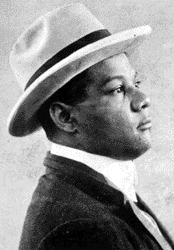 |
| Sidney Bechet |
Influential clarinet innovator
Bechet really does deserve a mention alongside the early giants, first because he was a huge influence on clarinet sound in early jazz, even though he was barely a teenager when he began exerting this influence, and second because we can hear in him, along with Armstrong, the sound of the next stage in jazz.
The reason I might have swithered about including him here is that actually I think his best work comes later. However, it would just have seemed deliberately perverse not to give him a mention at this point.
“Difficult” personality
Although loved by his fans, Bechet was not universally loved as a person by other musicians. He was early to tour jazz to Europe, including to the UK in the Teens. In the late 20s he is imprisoned in France for injuring a passerby during a shootout with another musician over an argument about chord changes. Yes, really!
Wild Cat Blues
The track I have chosen is his first recording session, Wild Cat Blues, from 1923. He is the featured artist with Clarence Williams' Blue Five. Straight away you can hear that this is not ensemble playing as we have heard so far. This is a showcase for Bechet (and the band actually gives pretty average at best performance anyway). Bechet is playing soprano sax here, and he totally dominates the tune.
The next thing to notice is that it isn’t actually blues (although Bechet can be very bluesy when he chooses). Wild Cat Blues doesn’t have a bluesy feel, and it doesn’t follow a blues chord structure. It’s far more raggy: it has a succession of four themes. In many of his improvisations he is simply arpeggiating the chords, but listen to his more novel break in the minor key section at around 2:18. He completely breaks away from the beat here, holding a high note for a minim’s length, with an intense vibrato, then a little flick before accenting the fourth beat of the bar. It’s a rhythmically adventurous lick, and it cuts right through the accompaniment.
Bechet on CD:
You might want to consider The Complete American Masters 1931-1953 from Decca, a 14-CD set (which actually does include Wild Cat Blues from 1923, despite the set’s title!). However, be aware that the case is the size of a shoebox, so it won’t fit your CD shelves. It’ll cost you £28 - £30.
A cheaper option is the 1 CD Legendary Sidney Bechet, 1932-1941 from RCA Bluebird. This doesn’t have Wild Cat Blues, but does have a good selection of his notable recordings.


No comments:
Post a Comment